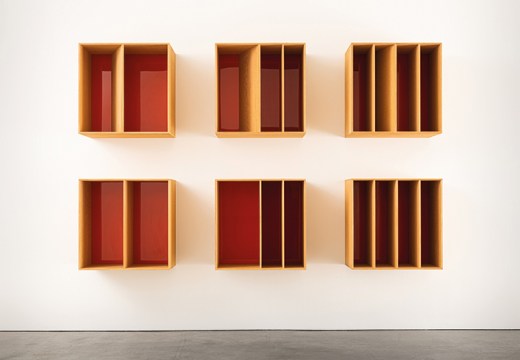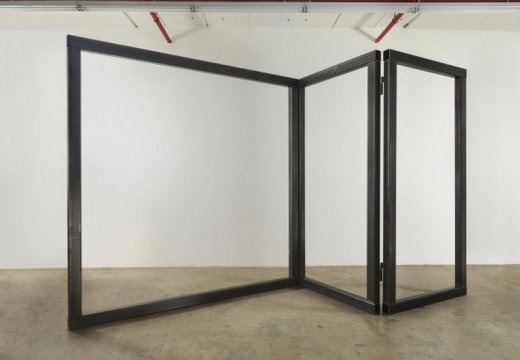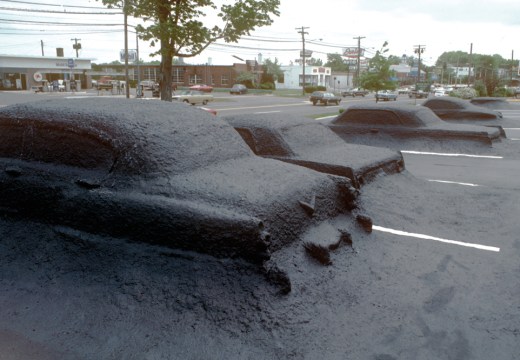In a text accompanying an exhibition of her work in 1967, the German artist Charlotte Posenenske asked only one thing of her audience: ‘Have fun!’ This playful attitude was embedded in the way she presented her sculptural series, which she invited audiences to assemble or move around. When earlier that year she had debuted her Vierkantrohre Serie DW (Square Tubes Series DW) during a one-night event at Galerie Dorothea Loehr in Frankfurt, for instance, she had enlisted a crew of men wearing Lufthansa overalls to rearrange the elements of these cardboard constructions throughout the evening. On this occasion, at the Kleine Gallery in Schwenningen, she showed Serie DW alongside Vierkantrohre Serie D (1967), another series of hollow forms, this time made from sheets of steel. A newspaper headline referred to the works as ‘Art Toys for the Exhibition Visitors […] Bizarre but Debatable’.
It’s this flair for theatricality – perhaps stemming from the artist’s brief stint in the early 1950s as a set and costume designer for regional German theatres – that’s somewhat lacking in ‘Charlotte Posenenske: Work in Progress’, currently on view at Kunstsammlung Nordrhein-Westfalen in Düsseldorf (the exhibition was organised by Dia Art Foundation, and is touring to multiple venues). While it is well-researched and expansive, spanning all 12 years of Posenenske’s short yet prolific artistic career, the survey relies largely on video and photo documentation, instead of the sculptures, to draw out the more performative aspects of her practice.

Installation view of Vierkantrohre Serie D (1967) by Charlotte Posenenske in the foyer of the Kunstsammlung Nordrhein-Westfalen, Düsseldorf. Photo: Achim Kukulies
When it comes to exhibiting kinetic or participatory artwork, curators are challenged with the unenviable task of balancing the original intentions of the artist with concerns about conservation for future audiences. But this problem isn’t applicable here. After her death from cancer at the age of 54, the artist’s widower Burkhard Brunn, in accordance with Posenenske’s wishes, authorised reproduction of her sculptures – the original sculptures were then reclassified as ‘prototypes’ – in unlimited, unsigned series. It’s a decision that offers countless opportunities for viewer interaction, unavailable when loaning valuable pieces, that the exhibition doesn’t make full use of. Set in the middle of the hall, examples from Serie D and Serie DW, we’re told, will be reconfigured at some point during the exhibition’s run: but what better way to introduce audiences to this overlooked artist than, say, inviting another artist to completely reinstall the show midway through its duration, as the curators of the Félix González-Torres retrospective at Frankfurt’s MMK in 2011 did with Tino Sehgal?
Such a strategy would underscore the democratic nature of Posenenske’s sculptures which, in line with minimalist strategies at the time, were industrially produced and questioned notions of authorship by allowing the ‘customer’, as she called them, to decide on how their individual parts should be combined. Take Posenenske’s Drehflügel Serie E (Revolving Vanes Series E; 1967–68) – the last series Posenenske realised before she left the art world to pursue a career in sociology (a decision motivated, she wrote, by her growing feeling that ‘art cannot contribute to the solution of pressing social problems’). These room-like, square or triangular objects have moveable doors or partitions for viewers to open and close at will. When replicas of Serie E were exhibited at Tate Modern in 2016, they became, in the words of the curator Catherine Wood, ‘a stage for a mass game of hide-and-seek among […] several thousand schoolchildren’. When I opened the doors of the Serie E element in ‘Work in Progress’, a museum guard quickly came by to close them again.

Charlotte Posenenske with Drehflügel Serie E (Revolving Vanes Series E) at Frankfurt airport in 1968. Photo: Gabriele Lorenzer-Walther; Courtesy the Estate of Charlotte Posenenske, Mehdi Chouakri, Berlin, Konrad Fischer, Düsseldorf, Sofie Van de Velde, Antwerp, Peter Freeman, New York and Take Ninagawa, Tokyo; © Estate of Charlotte Posenenske
That said, there are moments of brilliance on display – especially when the works migrate from the confines of the exhibition hall. Posenenske’s galvanised steel Serie D, which clearly resembles air ducts, comes into its own in the glass-paned foyer of the museum: in her lifetime, the artist regularly exhibited her sculptures in public or semi-public spaces, from traffic islands to Frankfurt airport. It is also a fascinating to see so many works from early in Posenenske’s career, including her Spachtelarbeiten (Palette Knife Works), which she made between 1956 and 1965. Created by spreading paint on and then scraping it off the canvas with a palette knife, they suggest that from the very beginning the artist was experimenting with ideas of process.

Prototype for Reliefs Serie A (Reliefs Series A; 1966), Charlotte Posenenske. Collezione La Gaia, Busca. Photo: Bill Jacobson Studio, New York; © Estate of Charlotte Posenenske
Then there are the rare prototypes for the artist’s Reliefs Serie A, B, and C (1966–68), folded or curved sheets of metal painted in red, blue, yellow or black and placed on the wall or ground. Four of the Serie B reliefs were included in Serielle Formationen (Serial Formations), a landmark survey of European and American serial art held in Frankfurt in 1967, where they were installed opposite a black wooden structure by Sol LeWitt. It is these reliefs that most eloquently argue for Posenenske’s place in the history books – and museum displays – alongside LeWitt, Donald Judd, Carl Andre, and other more celebrated conceptual artists.
‘Charlotte Posenenske: Work in Progress’ is at the Kunstsammlung Nordrhein-Westfalen, Düsseldorf, until 2 August.
Unlimited access from just $16 every 3 months
Subscribe to get unlimited and exclusive access to the top art stories, interviews and exhibition reviews.














![Masterpiece [Re]discovery 2022. Photo: Ben Fisher Photography, courtesy of Masterpiece London](http://www.apollo-magazine.com/wp-content/uploads/2022/07/MPL2022_4263.jpg)
Why are fathers so absent from art history?